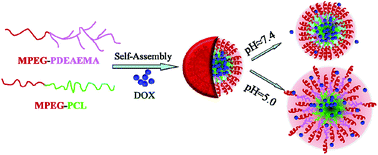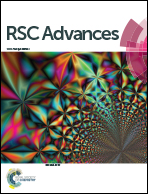Fabrication of PDEAEMA-based pH-responsive mixed micelles for application in controlled doxorubicin release
Abstract
Co-micellization of the diblock polymers poly(ethylene glycol) methyl ether-b-poly(N,N-diethylaminoethyl methacrylate) (MPEG–PDEAEMA) and poly(ethylene glycol) methyl ether-b-polycaprolactone (MPEG–PCL) was carried out to avoid the complicated synthetic steps of a single polymer and enhance the drug loading contents as well as the pH-responsive drug release performances of the polymers. The molecular weight and molecular structure of MPEG–PDEAEMA and MPEG–PCL were measured and confirmed by gel permeation chromatography (GPC) and 1H NMR. With the mass ratio of MPEG–PCL and MPEG–PDEAEMA set at 1 : 3, all three mixed micelles, MIX1 (MPEG–PCL40 and MPEG–PDEAEMA20), MIX2 (MPEG–PCL60 and MPEG–PDEAEMA35), and MIX3 (MPEG–PCL80 and MPEG–PDEAEMA50), showed good stability and excellent pH-responsive performances according to their critical micellar concentrations (CMC), particle sizes, and zeta potentials. The doxorubicin (DOX) loading content (LC) and entrapment efficiency (EE) of the micelles were 26.79% and 63.19% (MIX1), 22.81% and 59.03% (MIX2), and 21.46% and 54.65% (MIX3), respectively. As the PDEAEMA/PCL content increased, the drug loading content decreased, which was further confirmed by dissipative particle dynamics (DPD) simulations. The results indicate that the mixed micelles developed in this study might have some advantages in improving the drug loading capacity of the polymers. The drug release profiles demonstrate that the mixed micelles have excellent ability for the controlled release of DOX, suggesting great potential for application of the micellar systems in drug delivery, especially in the area of pH-targeted tumor treatment.



 Please wait while we load your content...
Please wait while we load your content...